Criminology and Criminal Justice: Car Theft in Australia Analysis
VerifiedAdded on 2021/06/16
|5
|1155
|97
Essay
AI Summary
This essay, focusing on car theft in Australia, argues that it results in significant costs to the Australian public. It delves into the financial impact, citing approximately A$1 billion per year in losses, and explores the connection between car theft and unemployment, highlighting how economic hardship can drive individuals to commit such crimes. The essay also examines the vulnerability of certain communities and the involvement of juveniles in car theft. It further explains the structural theories of crime, particularly the strain theory, which posits that the gap between societal goals and the means to achieve them leads to criminal behavior, making strain theory a better explanation for car theft. The essay supports its arguments with research and relevant literature, including the Australian Bureau of Statistics and academic journals, to provide a comprehensive analysis of car theft and its underlying causes.
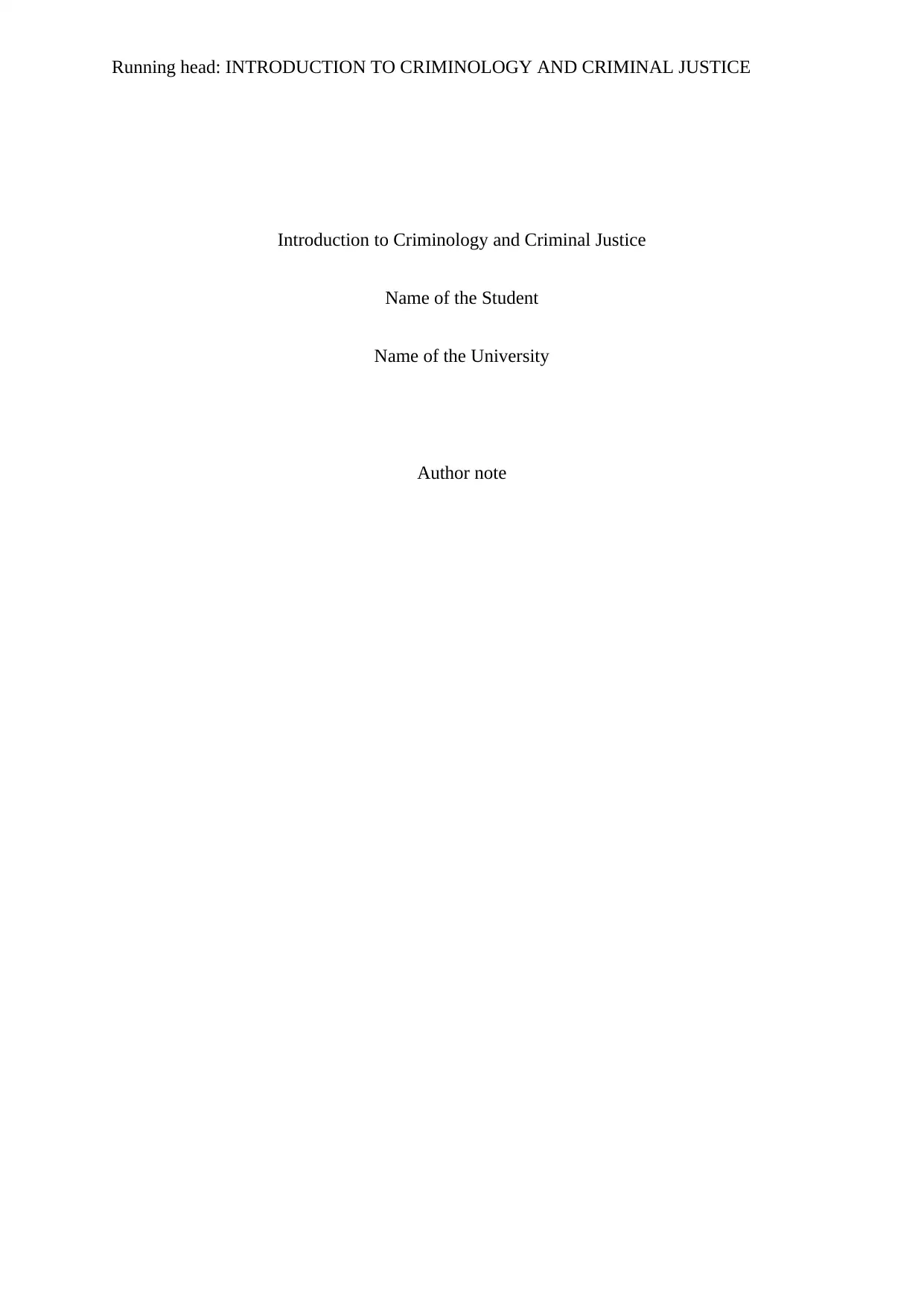
Running head: INTRODUCTION TO CRIMINOLOGY AND CRIMINAL JUSTICE
Introduction to Criminology and Criminal Justice
Name of the Student
Name of the University
Author note
Introduction to Criminology and Criminal Justice
Name of the Student
Name of the University
Author note
Paraphrase This Document
Need a fresh take? Get an instant paraphrase of this document with our AI Paraphraser
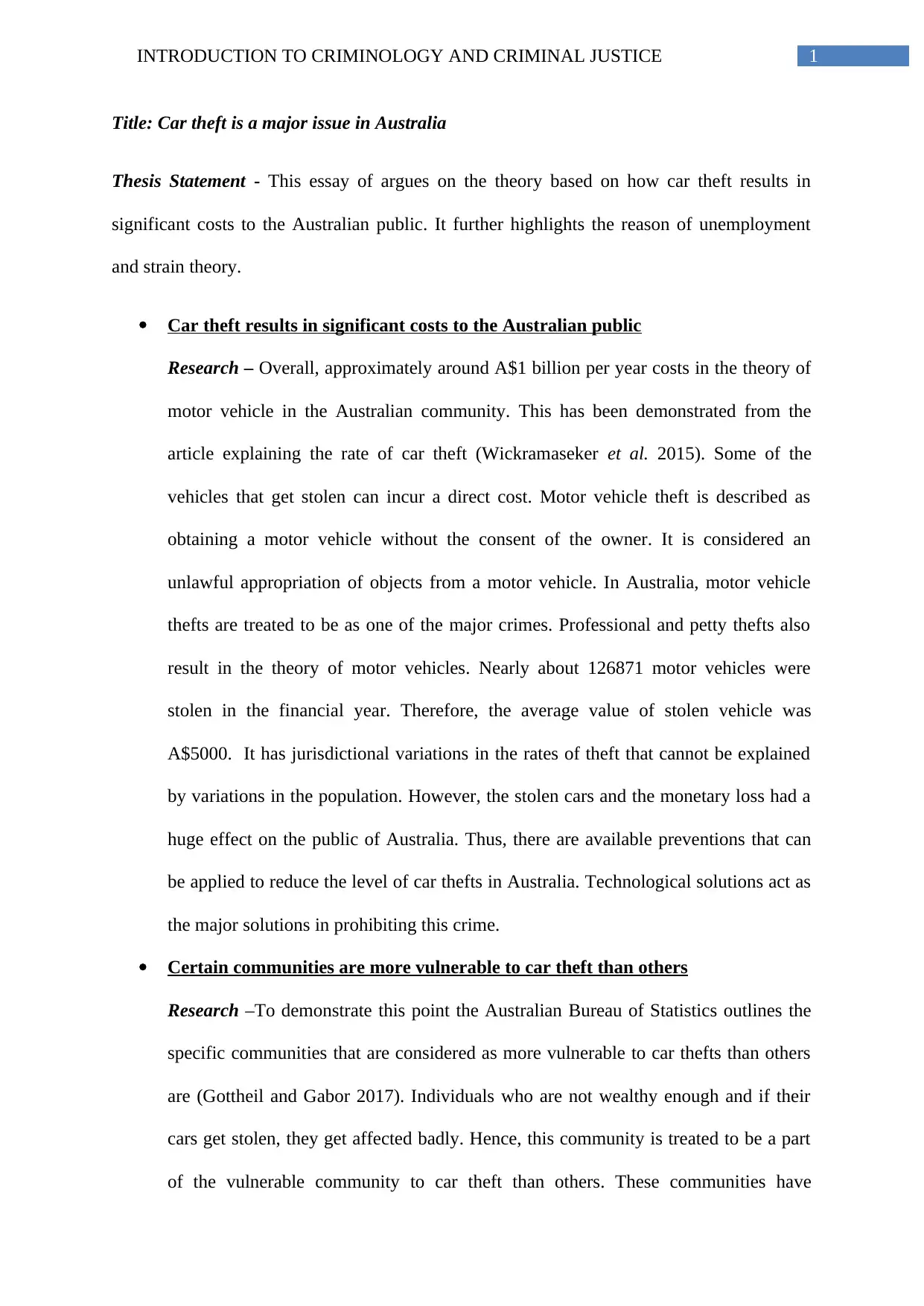
1INTRODUCTION TO CRIMINOLOGY AND CRIMINAL JUSTICE
Title: Car theft is a major issue in Australia
Thesis Statement - This essay of argues on the theory based on how car theft results in
significant costs to the Australian public. It further highlights the reason of unemployment
and strain theory.
Car theft results in significant costs to the Australian public
Research – Overall, approximately around A$1 billion per year costs in the theory of
motor vehicle in the Australian community. This has been demonstrated from the
article explaining the rate of car theft (Wickramaseker et al. 2015). Some of the
vehicles that get stolen can incur a direct cost. Motor vehicle theft is described as
obtaining a motor vehicle without the consent of the owner. It is considered an
unlawful appropriation of objects from a motor vehicle. In Australia, motor vehicle
thefts are treated to be as one of the major crimes. Professional and petty thefts also
result in the theory of motor vehicles. Nearly about 126871 motor vehicles were
stolen in the financial year. Therefore, the average value of stolen vehicle was
A$5000. It has jurisdictional variations in the rates of theft that cannot be explained
by variations in the population. However, the stolen cars and the monetary loss had a
huge effect on the public of Australia. Thus, there are available preventions that can
be applied to reduce the level of car thefts in Australia. Technological solutions act as
the major solutions in prohibiting this crime.
Certain communities are more vulnerable to car theft than others
Research –To demonstrate this point the Australian Bureau of Statistics outlines the
specific communities that are considered as more vulnerable to car thefts than others
are (Gottheil and Gabor 2017). Individuals who are not wealthy enough and if their
cars get stolen, they get affected badly. Hence, this community is treated to be a part
of the vulnerable community to car theft than others. These communities have
Title: Car theft is a major issue in Australia
Thesis Statement - This essay of argues on the theory based on how car theft results in
significant costs to the Australian public. It further highlights the reason of unemployment
and strain theory.
Car theft results in significant costs to the Australian public
Research – Overall, approximately around A$1 billion per year costs in the theory of
motor vehicle in the Australian community. This has been demonstrated from the
article explaining the rate of car theft (Wickramaseker et al. 2015). Some of the
vehicles that get stolen can incur a direct cost. Motor vehicle theft is described as
obtaining a motor vehicle without the consent of the owner. It is considered an
unlawful appropriation of objects from a motor vehicle. In Australia, motor vehicle
thefts are treated to be as one of the major crimes. Professional and petty thefts also
result in the theory of motor vehicles. Nearly about 126871 motor vehicles were
stolen in the financial year. Therefore, the average value of stolen vehicle was
A$5000. It has jurisdictional variations in the rates of theft that cannot be explained
by variations in the population. However, the stolen cars and the monetary loss had a
huge effect on the public of Australia. Thus, there are available preventions that can
be applied to reduce the level of car thefts in Australia. Technological solutions act as
the major solutions in prohibiting this crime.
Certain communities are more vulnerable to car theft than others
Research –To demonstrate this point the Australian Bureau of Statistics outlines the
specific communities that are considered as more vulnerable to car thefts than others
are (Gottheil and Gabor 2017). Individuals who are not wealthy enough and if their
cars get stolen, they get affected badly. Hence, this community is treated to be a part
of the vulnerable community to car theft than others. These communities have
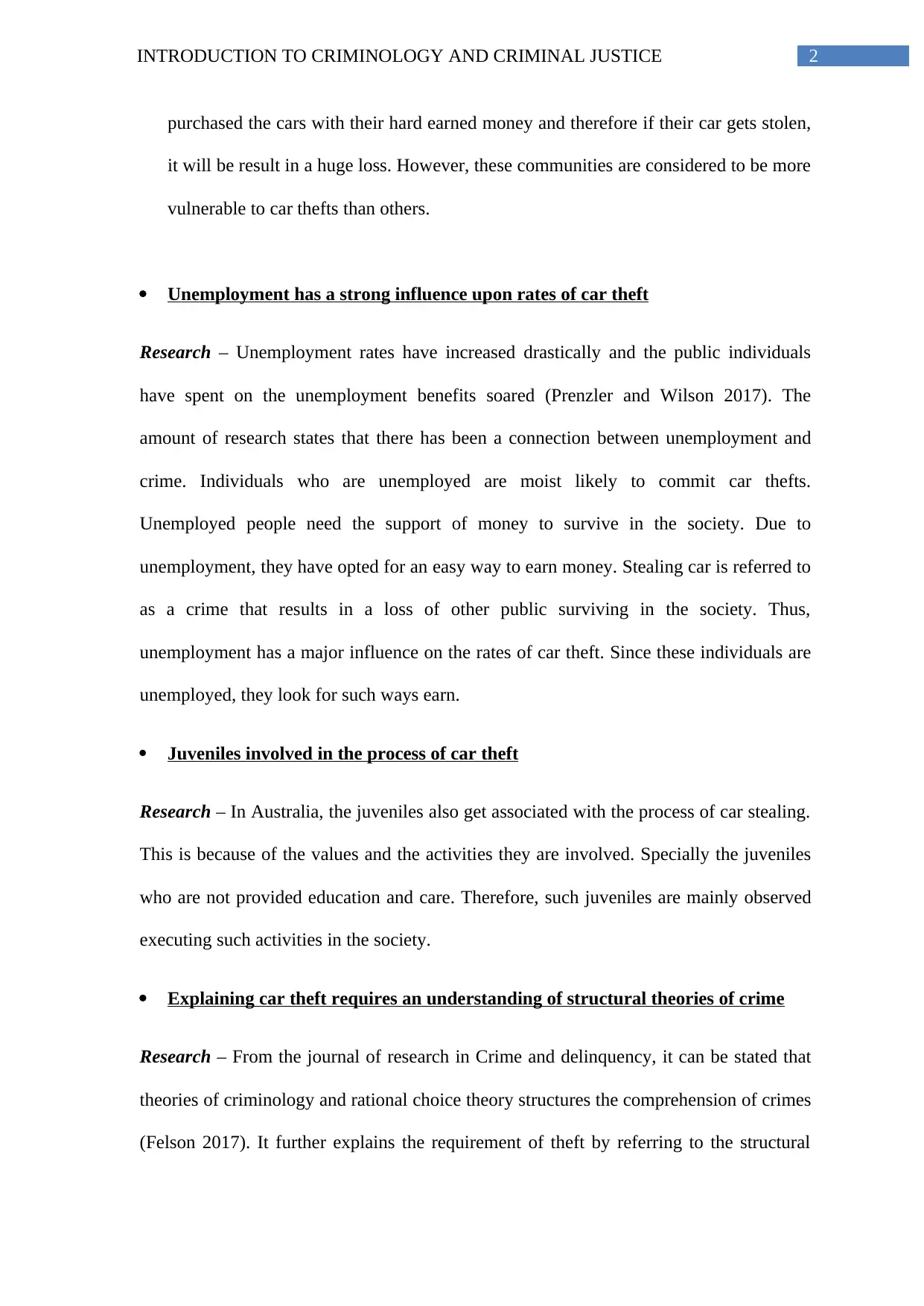
2INTRODUCTION TO CRIMINOLOGY AND CRIMINAL JUSTICE
purchased the cars with their hard earned money and therefore if their car gets stolen,
it will be result in a huge loss. However, these communities are considered to be more
vulnerable to car thefts than others.
Unemployment has a strong influence upon rates of car theft
Research – Unemployment rates have increased drastically and the public individuals
have spent on the unemployment benefits soared (Prenzler and Wilson 2017). The
amount of research states that there has been a connection between unemployment and
crime. Individuals who are unemployed are moist likely to commit car thefts.
Unemployed people need the support of money to survive in the society. Due to
unemployment, they have opted for an easy way to earn money. Stealing car is referred to
as a crime that results in a loss of other public surviving in the society. Thus,
unemployment has a major influence on the rates of car theft. Since these individuals are
unemployed, they look for such ways earn.
Juveniles involved in the process of car theft
Research – In Australia, the juveniles also get associated with the process of car stealing.
This is because of the values and the activities they are involved. Specially the juveniles
who are not provided education and care. Therefore, such juveniles are mainly observed
executing such activities in the society.
Explaining car theft requires an understanding of structural theories of crime
Research – From the journal of research in Crime and delinquency, it can be stated that
theories of criminology and rational choice theory structures the comprehension of crimes
(Felson 2017). It further explains the requirement of theft by referring to the structural
purchased the cars with their hard earned money and therefore if their car gets stolen,
it will be result in a huge loss. However, these communities are considered to be more
vulnerable to car thefts than others.
Unemployment has a strong influence upon rates of car theft
Research – Unemployment rates have increased drastically and the public individuals
have spent on the unemployment benefits soared (Prenzler and Wilson 2017). The
amount of research states that there has been a connection between unemployment and
crime. Individuals who are unemployed are moist likely to commit car thefts.
Unemployed people need the support of money to survive in the society. Due to
unemployment, they have opted for an easy way to earn money. Stealing car is referred to
as a crime that results in a loss of other public surviving in the society. Thus,
unemployment has a major influence on the rates of car theft. Since these individuals are
unemployed, they look for such ways earn.
Juveniles involved in the process of car theft
Research – In Australia, the juveniles also get associated with the process of car stealing.
This is because of the values and the activities they are involved. Specially the juveniles
who are not provided education and care. Therefore, such juveniles are mainly observed
executing such activities in the society.
Explaining car theft requires an understanding of structural theories of crime
Research – From the journal of research in Crime and delinquency, it can be stated that
theories of criminology and rational choice theory structures the comprehension of crimes
(Felson 2017). It further explains the requirement of theft by referring to the structural
⊘ This is a preview!⊘
Do you want full access?
Subscribe today to unlock all pages.

Trusted by 1+ million students worldwide
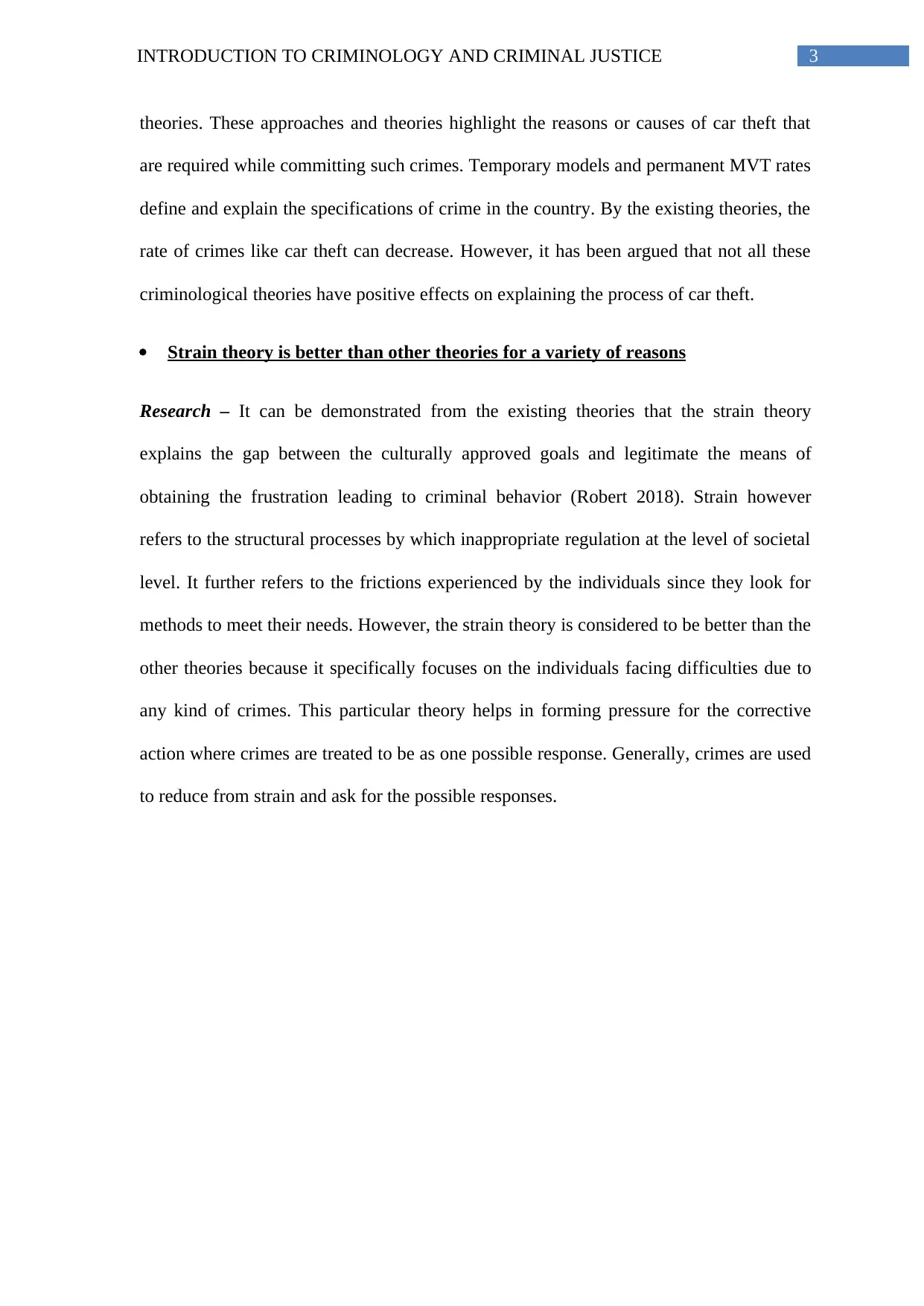
3INTRODUCTION TO CRIMINOLOGY AND CRIMINAL JUSTICE
theories. These approaches and theories highlight the reasons or causes of car theft that
are required while committing such crimes. Temporary models and permanent MVT rates
define and explain the specifications of crime in the country. By the existing theories, the
rate of crimes like car theft can decrease. However, it has been argued that not all these
criminological theories have positive effects on explaining the process of car theft.
Strain theory is better than other theories for a variety of reasons
Research – It can be demonstrated from the existing theories that the strain theory
explains the gap between the culturally approved goals and legitimate the means of
obtaining the frustration leading to criminal behavior (Robert 2018). Strain however
refers to the structural processes by which inappropriate regulation at the level of societal
level. It further refers to the frictions experienced by the individuals since they look for
methods to meet their needs. However, the strain theory is considered to be better than the
other theories because it specifically focuses on the individuals facing difficulties due to
any kind of crimes. This particular theory helps in forming pressure for the corrective
action where crimes are treated to be as one possible response. Generally, crimes are used
to reduce from strain and ask for the possible responses.
theories. These approaches and theories highlight the reasons or causes of car theft that
are required while committing such crimes. Temporary models and permanent MVT rates
define and explain the specifications of crime in the country. By the existing theories, the
rate of crimes like car theft can decrease. However, it has been argued that not all these
criminological theories have positive effects on explaining the process of car theft.
Strain theory is better than other theories for a variety of reasons
Research – It can be demonstrated from the existing theories that the strain theory
explains the gap between the culturally approved goals and legitimate the means of
obtaining the frustration leading to criminal behavior (Robert 2018). Strain however
refers to the structural processes by which inappropriate regulation at the level of societal
level. It further refers to the frictions experienced by the individuals since they look for
methods to meet their needs. However, the strain theory is considered to be better than the
other theories because it specifically focuses on the individuals facing difficulties due to
any kind of crimes. This particular theory helps in forming pressure for the corrective
action where crimes are treated to be as one possible response. Generally, crimes are used
to reduce from strain and ask for the possible responses.
Paraphrase This Document
Need a fresh take? Get an instant paraphrase of this document with our AI Paraphraser
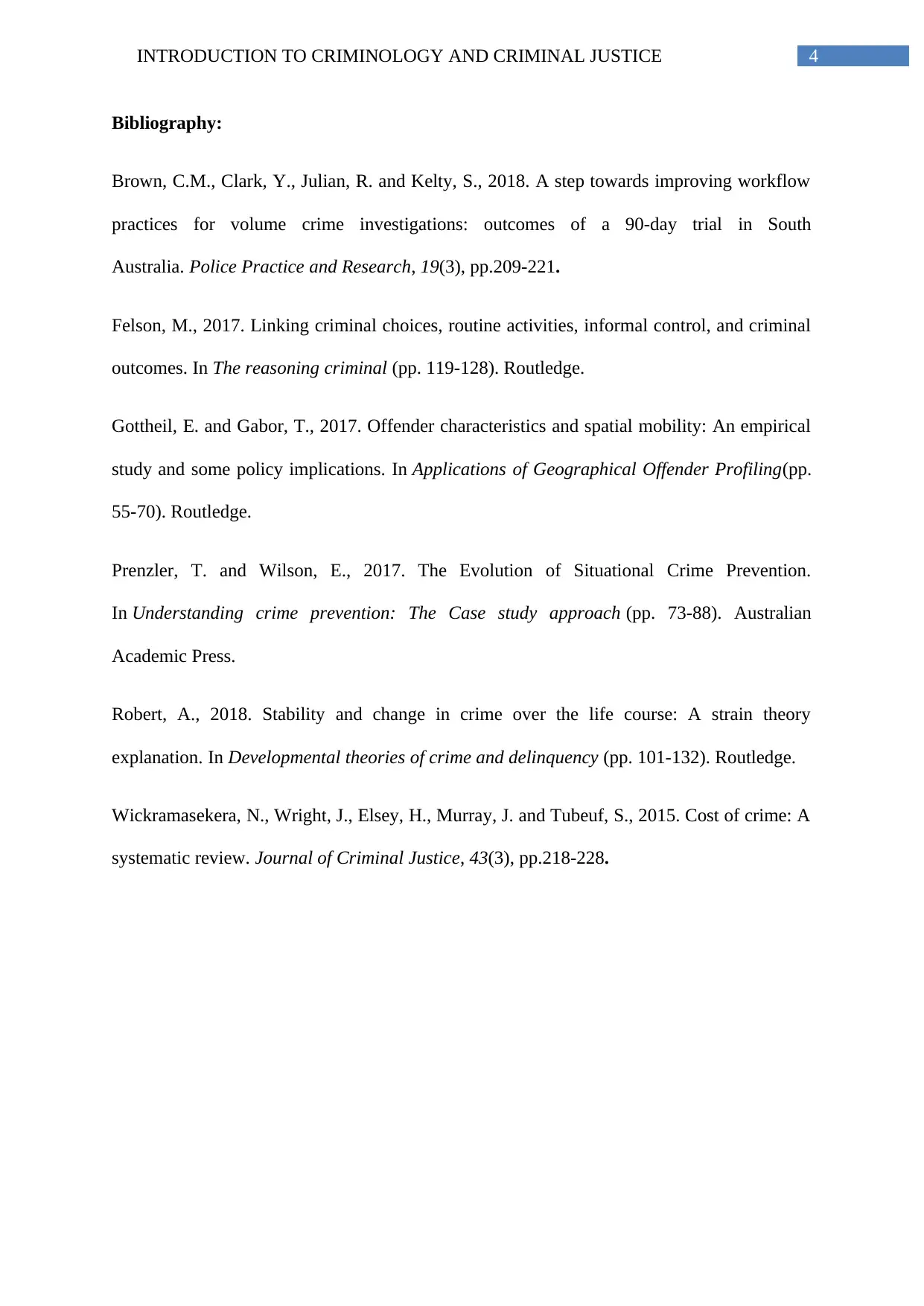
4INTRODUCTION TO CRIMINOLOGY AND CRIMINAL JUSTICE
Bibliography:
Brown, C.M., Clark, Y., Julian, R. and Kelty, S., 2018. A step towards improving workflow
practices for volume crime investigations: outcomes of a 90-day trial in South
Australia. Police Practice and Research, 19(3), pp.209-221.
Felson, M., 2017. Linking criminal choices, routine activities, informal control, and criminal
outcomes. In The reasoning criminal (pp. 119-128). Routledge.
Gottheil, E. and Gabor, T., 2017. Offender characteristics and spatial mobility: An empirical
study and some policy implications. In Applications of Geographical Offender Profiling(pp.
55-70). Routledge.
Prenzler, T. and Wilson, E., 2017. The Evolution of Situational Crime Prevention.
In Understanding crime prevention: The Case study approach (pp. 73-88). Australian
Academic Press.
Robert, A., 2018. Stability and change in crime over the life course: A strain theory
explanation. In Developmental theories of crime and delinquency (pp. 101-132). Routledge.
Wickramasekera, N., Wright, J., Elsey, H., Murray, J. and Tubeuf, S., 2015. Cost of crime: A
systematic review. Journal of Criminal Justice, 43(3), pp.218-228.
Bibliography:
Brown, C.M., Clark, Y., Julian, R. and Kelty, S., 2018. A step towards improving workflow
practices for volume crime investigations: outcomes of a 90-day trial in South
Australia. Police Practice and Research, 19(3), pp.209-221.
Felson, M., 2017. Linking criminal choices, routine activities, informal control, and criminal
outcomes. In The reasoning criminal (pp. 119-128). Routledge.
Gottheil, E. and Gabor, T., 2017. Offender characteristics and spatial mobility: An empirical
study and some policy implications. In Applications of Geographical Offender Profiling(pp.
55-70). Routledge.
Prenzler, T. and Wilson, E., 2017. The Evolution of Situational Crime Prevention.
In Understanding crime prevention: The Case study approach (pp. 73-88). Australian
Academic Press.
Robert, A., 2018. Stability and change in crime over the life course: A strain theory
explanation. In Developmental theories of crime and delinquency (pp. 101-132). Routledge.
Wickramasekera, N., Wright, J., Elsey, H., Murray, J. and Tubeuf, S., 2015. Cost of crime: A
systematic review. Journal of Criminal Justice, 43(3), pp.218-228.
1 out of 5
Related Documents
Your All-in-One AI-Powered Toolkit for Academic Success.
+13062052269
info@desklib.com
Available 24*7 on WhatsApp / Email
![[object Object]](/_next/static/media/star-bottom.7253800d.svg)
Unlock your academic potential
Copyright © 2020–2025 A2Z Services. All Rights Reserved. Developed and managed by ZUCOL.




